Saturday, November 20, 2021
Kashmiri Cuisine
Wednesday, November 17, 2021
Sharda temple
original Photo of the last caretaker of
Sharda temple Sh Prakash Ram ji of Batergam Kupwara , Maharaja Gulabsingh ji had assighned the lookafter , mentenance to the Hindus of Gotingoo Kupwara , many saints would go there and perform Tapasya,get enlightened,but saints had nothing to do for mentaining the Asthapan as claimed by so called history makers , thanks to Mata Sharda Trusts of Gushi Kupwara and Bandipora who have constructed Sharda Mata temples ,
Sunday, November 14, 2021
Saturday, November 13, 2021
Ziarat at Shiv-Sopore, Tujar, Nadihal and Janbab Sab at Baramulla
Thursday, 14 August 2014
Ziarat at Shiv-Sopore, Tujar, Nadihal and Janbab Sab at Baramulla
| Village Shiv Sopore |
| Village Doru, the birthplace of Syed Ali Shah Geelani |
| Add caption Local at the village Shiv Sopore |
| Ziarat of the Khalif of Makdoom Sahab at Shiv Sopore |
| Jan Bab Sabenie Deigh at Bramulla |
| National Flag hoisting atop the hillock in Baramulla |
8th August, 2014 Mohammad Rafiq and Mrs Rafiq planned to pay obeisance on 9th August at different places of Ziarat at Tujar- Sopore the birth place of Makdoom Sahib, Shiv-Sopore, Nadihal and Janbab Sahib at Baramulla. It was to express gratitude for having been blessed with a handsome son Kafil the third child after the couple was blessed with two academically brilliant and disciplined daughters.
Rafiq had decided to exclude me from the troupe. He apprehended that I might get bored and might not be interested in such a long entourage to different Ziarats of not any interest to me. I did not agree with him especially when the areas were virgin areas for me. Finally my request was conceded provided I did not discuss matters regarding militancy, turmoil and exodus with strangers. He cautioned me. Tujar and Shiv are villages adjacent to Dour Sopore, the village of Syed Ali Shah Gilani, the separatist leader.
We left Srinagar at 7:30 A M on 9th August, 2014 after routine breakfast. Rafiq took control of the steering and I took my seat next to the driver’s seat. Three children preferred the rear seat to enjoy warmth of their mother. 9 a.m. we reached Shiv Sopore where Najeeb Kirmani was already on wait for us at the market place. Zigzag drive through serpentine village narrow lanes, we joined the advance party headed by Moulvi Habib-Ullah Kirmani, the Imam of Maisuma Masjid.
We were lead to neat and well furnished drawing-room. Host welcomed us and soon dining cloth was laid out. Press and serve thermos filled with ‘sheirie chaie’ along with crockery items took their respective positions. The host was already informed that mutton be not prepared and served. ‘Tomlea choet’ (Thin chapatti made of rice flour), fried pieces of chicken and roasted corncobs in succession were the specialties of the breakfast
By 3: 30 p.m. all the Ziarats at different places were paid obeisance. The last Ziarat was Janbab Sahib at Baramulla. Right from my childhood I had heard the name Janbab Sabenie Degh. The name was used metaphorically. For the first time I saw with my naked eyes the famous and legendry metallic ware known as Janbab Sabenie Degh. 1.5 quintals of rice with other ingredients is cooked in the ware at a time.
Our next destination was the picnic spot on the bank of the River Jehlum that feeds NHPC power project and JVPP before it crosses the LOC. En route the scenic beauty is marvelous. The river is channelized to the projects. At places it runs over ground and at places it runs in kilometers under ground through man-made tunnels.
The two cars came to rest and the occupiers relieved their respective seats. All fanned in different directions. I ascended a number of steps of stairs and was delighted to discover a neat and clean washroom of a temporary neighbour and a tap with running water. Soon I declared my discovery to the delight of the rest. Source to the tap is a spring with natural mineral water.
Mohammad Rafiq, Moulvi Sahib and Danish fixed their fishing rods tipped with chicken intestine as bait. All sat for lunch and I occupied my seat on the folding stool. I was the only exception to be pure vegetarian for the lunch.
| Add captionThe River Jehlum feeder of the NHPC Power project |
| He is Ghulam Hassan, one of the locals. |
Local boys trickled around. I introduced myself to them as a Kashmiri Pundit in exile at 75. They were nice to talk to. Some invited me to their home. I asked them if I could get some accommodation for a few days on rent. In one voice all of them offered accommodation free of any rent. One boy with an eternal smile on his face took my mobile set to his home nearby for recharge of its battery. It was discovery of a lost treasure. It was their natural age-old culture. On their persuasion I decided to stay back for the night but Mohammad Rafiq did not accede to my decision. I could not resist. I revealed them the apprehensions of Kashmiri Pundits in exile against local Muslims. I told them that my elder brother, my daughters and my son-in-law phone me daily and very often to know my welfare.
7 p.m. fishing rods without any catch crawled back into their captivity. Our return was through a wide and smooth Uri road.
Before I went to bed I savoured on one chapatti for my dinner and returned the two to be served as breakfast on 10th.
Friday, November 12, 2021
Vahana
Vahana (Sanskrit: वाहन, Vāhanam or animal vehicle, literally "that which carries, that which pulls") denotes the being, typically an animal or mythical entity, a particular Hindu deity is said to use as a vehicle. In this capacity, the vahana is often called the deity's "mount". Upon the partnership between the deity and his vahana is woven much iconography and mythology. Deities are often depicted riding (or simply mounted upon) the vahana. Other times, the vahana is depicted at the deity's side or symbolically represented as a divine attribute. The vahana may be considered an accoutrement[1] of the deity: though the vahana may act independently, they are still functionally emblematic or even syntagmatic of their "rider". The deity may be seen sitting or standing on the vahana. They may be sitting on a small platform called a howdah, or riding on a saddle or bareback.[2] Vah in Sanskrit means to ride along the land.
Symbolism
In Hindu iconography, positive aspects of the vehicle are often emblematic of the deity that it carries. Nandi the bull, vehicle of Shiva, represents strength and virility. Dinka the mouse, vehicle of Ganesha, represents speed and sharpness. Parvani the peacock, vehicle of Skanda, represents splendor and majesty. The hamsa, vehicle of Saraswati, represents wisdom, grace and beauty.
However, the vehicle animal also symbolizes the evil forces over which the deity dominates. Mounted on Parvani, Skanda reins in the peacock's vanity. Seated on Dinka the rat (Mushika), Ganesh crushes useless thoughts, which multiply like rats in the dark. Shani, protector of property, has a vulture, raven or crow in which he represses thieving tendencies. Under Shani's influence, the vahana can make even malevolent events bring hope.
Origin folklore
The vehicle of a deity can vary according to the source, the time, and the place. In popular tradition, the origin of each vehicle is told in thousands of different ways.[citation needed] Three examples:
- While the god Ganesha was still a child, a giant mouse began to terrorize all his friends. Ganesha trapped him with his lasso and made him his mount. Mushika was originally a gandharva, or celestial musician. After absent mindedly walking over the feet of a rishi (sage) named Vamadeva, Mushika was cursed and transformed into a mouse. However, after the rishi recovered his temper, he promised Mushika that one day, the gods themselves would bow down before him. The prophecy was fulfilled when the mouse became the vahana of Ganesha.
- Before becoming the vehicle of Shiva, Nandi was a deity called Nandikeshvara, lord of joy and master of music and dance. Then, without warning, his name and his functions were transferred to the aspect of Shiva known as the deity Nataraja. From half-man, half-bull, he became simply a bull. Since that time, he has watched over each of Shiva's temples, always looking towards him.
- Kartikeya, the war-god known as Murugan in Southern India, is also mounted on a peacock. This peacock was originally a demon called Surapadma, while the rooster was called the angel[Krichi]. After provoking Murugan in combat, the demon repented at the moment his lance descended upon him. He took the form of a tree and began to pray. The tree was cut in two. From one half, Murugan pulled a rooster, which he made his emblem, and from the other, a peacock, which he made his mount. In another version, Karthikeya was born to kill the demon, Tarakasura. He was raised by the Krittikas and led the divine armies when he was 6 days old. It is said that after defeating Tarakasura, the god forgave him and transformed him into his ride, the peacock.
Origin theories
The vahana and deity to which they support are in a reciprocal relationship. Vahana serve and are served in turn by those who engage them. Many vahana may also have divine powers or a divine history of their own. Case in point, the aforementioned Nataraja story, represents a conflation of Hindu gods with local gods, syncretizing their mythos as their territories began to overlap. According to one source, "they could be a synthesis between Vedic deities and autochthonous Dravidian totemic deities.[citation needed]
Compared to other belief systems
The animal correspondences of Hindu vehicles are not consistent with Greek and Roman mythology, or other belief systems which may tie a particular animal to a particular deity. For example, the goddess Lakshmi of the Hindus has elephants, or an owl, or (a rare instance of a non-animal vehicle) the lotus blossom as her vehicle. The goddess Athena of ancient Greece also had an owl as her emblematic familiar, but the meanings invested in the owls by the two different belief systems are not the same, nor are the two goddesses themselves similar, despite their mutual identification with owls.
Lakshmi is, among other things, primarily the goddess of wealth, and her owl is a warning against distrust and isolationism, even selfishness. Athena, though also a goddess of prosperity, is primarily the goddess of wisdom, and her owl symbolizes secret knowledge and scholarship. Perhaps due to their shared geography, the Greco-Roman interpretation is paralleled in Roman Catholic iconography, in which St. Jerome, most famed for editing the New Testament, is often (though not always) depicted with an owl as a symbol of wisdom and scholarship.[3] Depending on the tribe, Native American religious iconography attributes a wide range of attributes to the owl, both positive and negative, as do the Ainu and Russian cultures, but none parallel the Hindu attributes assigned to the owl as Lakshmi's divine vehicle.[4]
Some hold that similar analyses could be performed cross-culturally for any of the other Hindu divine vehicles, and in each case, any parallels with the values assigned to animal totems in other cultures are likely to be either coincidence, or inevitable (as in linking bulls to virility), rather than evidence of parallel development. In dialectic, this is countered by the retort that each totem or vahana, as an aspect of ishta-devata (or an ishta-devata or asura in its own right), has innumerable ineffable teachings, insights and spiritual wisdom; comparative analysis yields benefit, though knowledge and understanding is not served by collapsing their qualities into homogenous signification.
List of God vehicles
| Vahana | Deities associated | Image |
|---|---|---|
| Mouse | Ganesha (pictured) | 
|
| Horse | Kalki (pictured) , Revanta, Chandra (chariot of 10 white horses), Indra (chariot pulled by a horse named Uchchaihshravas), Surya (chariot pulled by seven horses or a seven-headed horse), , Khandoba | 
|
| Garuda (eagle, pictured) | Vishnu, Krishna, Vaishnavi | 
|
| Nandi (bull, pictured) | Shiva, Maheshvari, Ishan | 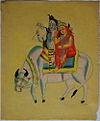
|
| Ram | Agni (pictured), Mangala | 
|
| Peacock | Kartikeya (pictured), Kaumari | 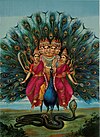
|
| Dog | Bhairava (pictured with dog as Vahana) | 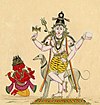
|
| Hamsa (Swan) | Brahma (pictured)[2] Brahmani, Saraswati, Gayatri, Vishvakarman | 
|
| Makara | Ganga, Varuna (pictured), Khodiyar | 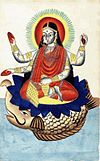
|
| Tiger | Chandraghanta, Kushmanda, Durga, Rahu, Ayyapan (pictured) | 
|
| Lion | Skandamata, Katyayani, Parvati (lion named Dawon), Budha, Chandika, Mariamman, Kamakhya, Narasimhi, Kaushiki, Jagaddhatri (pictured) | 
|
| Elephant | Indra (elephant named Airavata, pictured), Lakshmi, Shachi, Brihaspati | 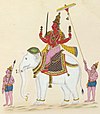
|
| Parrot | Meenakshi, Kama (named Sukha, pictured), Rati | 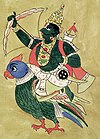
|
| Antelope | Chandra (chariot of), Vayu (pictured) | 
|
| Water buffalo | Yama (buffalo named Paundraka, pictured), Varahi | 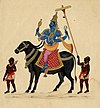
|
| Cat[5] | Shashthi | 
|
| Donkey | Kaalratri, Shitala (pictured), Kali (demon), Alakshmi | 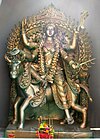
|
| Owl | Lakshmi[2][6] (pictured with the owl on her left, named Alooka), | 
|
| Vulture | Ketu (pictured) | 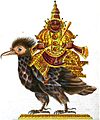
|
| Crow | Shani (pictured), Dhumavati | 
|
| Tortoise | Yamuna (pictured standing on it) | 
|
| Cockerel | Bahuchara Mata | 
|
| Cow | Dattatreya,Shailaputri(pictured), Mahagauri, Bhumi (chariot of seven cows) | 
|
| Snake | Manasa (picture) | 
|
| Corpse | Chamunda (pictured) | 
|
| Mongoose | Kubera | 
|
| Man | Nirrti, Nirrta (pictured), Kubera, Bhadrā Devi | 
|
| Jackel | Shivadooti |
|
These correspondences are not always consistent. Ganesh, for example, is sometimes shown with a peacock as his vehicle, although a peacock is the customary vehicle of his brother Kartikeya (also known as Murugan, Subramanya, Skanda and other names) as well as the vehicle sometimes associated with the goddess Saraswati. Even more rarely, the elephant-headed Ganesh may be seen riding another elephant, or a lion, or a many-headed serpent.[7]
The vahana, the mount or vehicle of a deity, serves the function of doubling a God's or Goddess' powers. The vahana also represents the devotee's mind which allows the deity to guide the devotee. Durga the warrioress could not have destroyed the demon Mahishasura without the aid of her vehicle, lion, which was given by her father Himalaya, for the stated purpose. Lakshmi, goddess of fortune, dispenses both material and spiritual riches from her mount, Uluka the owl. Ganesh, remover of obstacles, cannot go everywhere despite his elephant-like strength. However, his vehicle, Mushika the mouse, who can crawl into the smallest crevice or Akhuketana the rat, who can survive just about anywhere, can assist Ganesh to overcome the greatest obstacles.




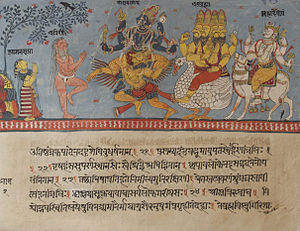
No comments:
Post a Comment